

© Shipping Wonders of the World 2012-

The Kiel Canal
The opening of the Kiel Canal in June 1895 by the German Emperor Wilhelm II marked an important stage in the growth of Germany as a maritime power. The canal made Kiel one of the greatest naval bases in Europe
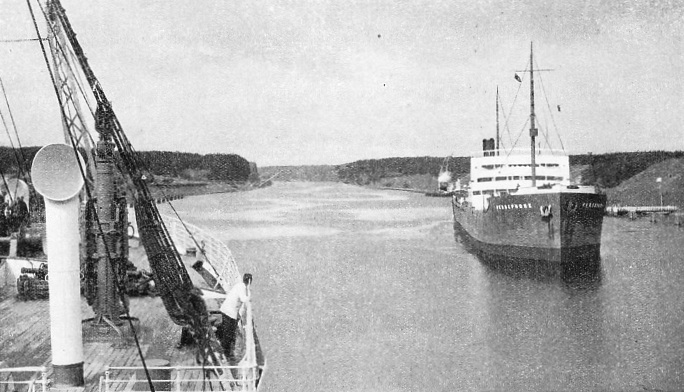
A TYPICAL REACH of the Kiel Canal between Rendsburg and the entrance at Kiel. This photograph was taken from the deck of the Royal Mail liner Atlantis, illustrated and described below. The vessel approaching is the Persephone, 8,921 tons gross. She was built at Kiel by Krupp in 1925 and is 468 ft. 8 in. long, with a beam of 63 ft. 3 in. and a depth of 35 ft. 2 in. The Kiel Canal is 338 feet wide at water-
THE Kiel Canal (Kaiser Wilhelm Kanal) links the North Sea with the Baltic, from Brunsbuttelkoog, at the mouth of the River Elbe, to Kiel-
The general direction of the canal from the Elbe is mainly north-
Opened originally in June 1895 by the Emperor William II, the canal was afterwards widened and deepened; it was reopened in June 1914. Under the terms of the Peace Treaty of Versailles (1919) merchant vessels and warships of nations at peace with Germany have equal rights of passage, although as foreign warships thus pass through German territorial waters, permission for transit has to be obtained through diplomatic channels.
The canal is one of the outstanding achievements of modern Germany. Before its opening ocean-
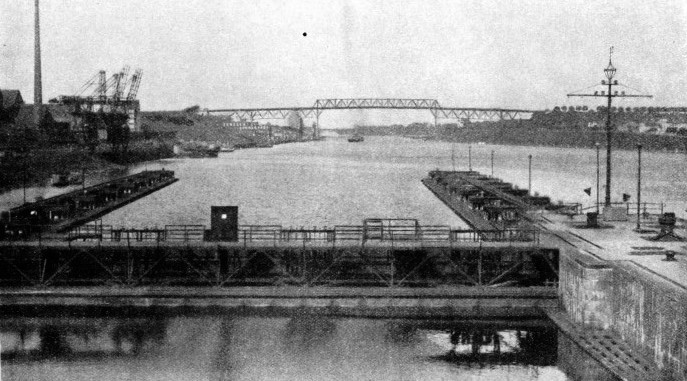
THE LOCKS AT HOLTENAU, at the eastern entrance to the Kiel Canal. The canal was rebuilt in 1914 at a cost of £11,009,030, and the new locks are 1,082 feet long, 148 feet wide and 39 feet deep. In the background of this photograph can be seen the Prinz Heinrich Bridge for vehicular traffic. The centre span of this bridge has a clearance of 138 feet.
The dangers of the passage round the Skaw (the northernmost point of Denmark) prompted the idea of a canal as early as the fourteenth century. It is said that when Cromwell was interested in Denmark and Sweden he considered a scheme; but nothing came of any project until the German Empire began to seek sea-
Count Moltke, at first an opponent of the scheme, changed his attitude and wrote, “The Empire itself will be a great gainer by the canal, for the canal will double the strength of our fleet by enabling us, unseen and unmolested by the enemy, to throw our whole naval force into the North Sea or into the Baltic Ocean.”
Marshes and shifting soil were drained and dredged, great embankments were made and road and railway bridges built at high levels to avoid interference with shipping. The high banks of the canal prevent the passenger from seeing the flat, dull country on either side, and in winter, when the wind blows from the Baltic, the canal is bitterly cold. Mariners who have been in the Arctic or the Antarctic and through the Kiel Canal have said that for bitter misery the Kiel Canal is the worst of the three.

FROM KIEL TO BRUNSBUTTELKOOG, at the mouth of the River Elbe, the Kiel Canal is fifty-
When the canal was being built it was called the North Sea and Baltic Canal, but this name was changed when the Emperor Wilhelm II opened the canal in June 1895. He named it the Kaiser Wilhelm Kanal, after his grandfather, Wilhelm I, in whose reign (June 1887) the canal had been begun. Wilhelm I died in 1888, his son Frederick reigned for only ninety-
The rest of the world called the canal the Kiel Canal, because at the Baltic end was the rapidly growing naval base. Wilhelm II made the opening ceremony a world event and the occasion marked the coming of age of the German Navy. The original cost was about £8,000,000, but the enlargement, completed just before the war of 1914-
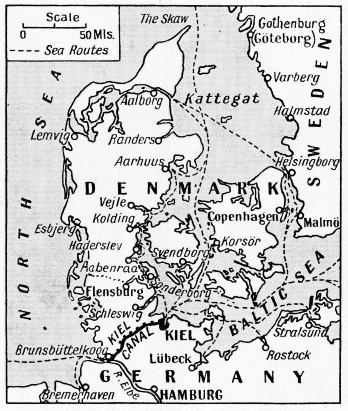 When the canal was opened the warships of the following nations assembled at Kiel: Austria-
When the canal was opened the warships of the following nations assembled at Kiel: Austria-
AN ARTIFICIAL OUTLET from the Baltic Sea. Before the opening of the Kiel Canal in 1895 vessels bound for Baltic ports had to make the long and difficult passage round the north coast of Denmark via the Skaw and the Kattegat. The distance from Hamburg to Kiel through the canal is only 121 nautical miles, against a distance of 646 miles round the coast.
The ceremonies were opened with a banquet given by the Senate of Hamburg, at which the German Emperor was present. At either end of the canal the decorations and arrangements were on an extensive scale, and at Hamburg an island was created for a special reason. The German Emperor had supervised every detail of the organization and had arranged the entire programme. When the scheme of the Hamburg festivities was laid before him he said that after the banquet the visitors should go to the Alster Island. The officials looked a little blank, but one plucked up the courage to tell the Emperor that no such island existed. “There is no island in the Alster basin, your Majesty,” he said, “but we can soon make one”. And so the About island was built, at a cost of about £25,000. Some 750 piles were driven and on them was erected an island of canvas, plaster, cement and wire-
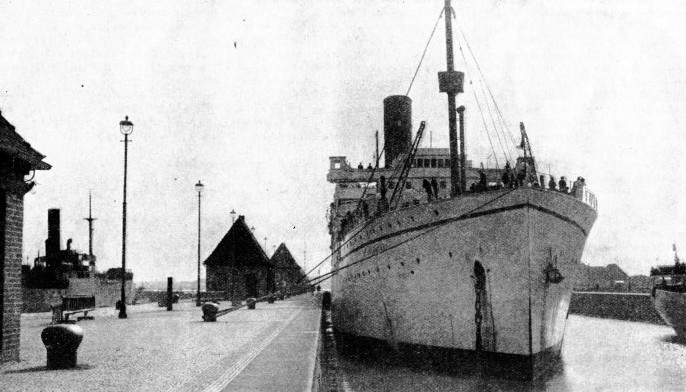
A CRUISING PASSENGER LINER, the Atlantis, alongside the quay in Holtenau lock. The Royal Mail Lines, Ltd., employ this vessel for cruises to Scandinavian and Baltic ports, as well as to many other places. A ship of 15,135 tons gross, she is 570 ft. 3 in. long, with a beam of 67 ft. 3 in. and a depth of 33 ft. 3 in. Ships up to 1,033 feet in length and 131 feet beam can use the Kiel Canal.
Conforming to schedule, the Hohenzollern entered the locks at Brunsbuttelkoog at 3.30 a.m. next day. Half an hour later she passed out of the locks and her stem severed a cord stretched across the canal, thus officially opening it. Behind the Hohenzollern were twenty-
Meanwhile the German Empress had arrived at Kiel the previous evening during a thunderstorm and every ship in the great fleet fired an imperial salute of thirty-
While the twenty-
An Unrehearsed Incident
Promptly at 12.45 p.m. the Hohenzollern steamed out of the locks at Holtenau into Kiel Harbour and the fleet saluted her with an imperial salute of 31 guns. The Kaiseradler followed the Hohenzollern according to plan. Then came an awkward pause, for there was no sign of the Kaiser Wilhelm II, the third vessel in the procession. Rumours flew from forecastle to quarterdeck and so through every vessel in the assembled fleet. One rumour was that the British royal yacht Osborne had stuck; this story was wired to England and printed, only to be indignantly denied the next day. The culprit was the 7,000-
Behind her steamed the Osborne, with the Duke of York aboard, and then came the rest of the procession. The trouble with the Kaiser Wilhelm II occurred in the bend of the canal at Levensau when the ship was almost at Holtenau.
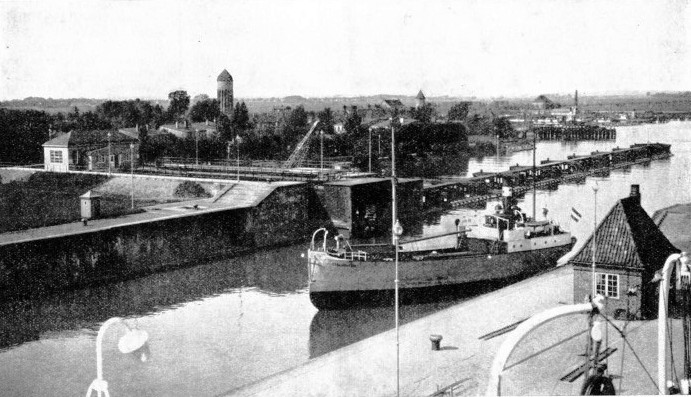
THE ENTRANCE LOCKS of the Kiel Canal from the River Elbe at Brunsbuttelkoog. The Carl Hedrich, seen in this photograph entering the locks, is typical of the smaller coastal vessels that regularly use the canal. Altogether 20,636 steam and motor vessels passed through the canal from Brunsbuttelkoog to Kiel in 1934. In the opposite direction the total number of vessels was 20,601. Every type of ship uses the canal, including warships, cargo and passenger ships, fishing vessels, tugs, barges and sailing vessels.
The centre of the festivities at Kiel was the Festhalle, or Festival Hall, built, at the Emperor’s suggestion, to resemble a three-
The port is divided into four sections: the Old Town Harbour, at the head of the inlet, Wik Harbour, on the south bank, at the entrance to the canal; the North Harbour, inside the canal locks on the south bank; and Vossbrook Harbour, north of the canal entrance.
The Old Town Harbour, which serves the town, has a depth of water of 20 feet alongside the 7,550 feet of quay walls. Wik Harbour, which is the free port of Kiel, has a depth of 33 feet alongside the 3,300 feet of berths, and has oil tanks and fuelling equipment. The North Harbour, built above the Kiel-
The principal imports are coal, oil, oilcake, maize, timber, grain, flour, bricks and fish; the chief exports are grain, flour, timber, bricks, salt, manure, machinery and industrial produce.
In the days of the Imperial Navy merchant ships were crowded out. After the war of 1914-
Vital Short-
There are many other works, shipyards and floating and dry docks. The numerous cranes, floating and stationary, lift up to 250 tons. The marine engineering plants of other companies add to the facilities of the port.
Its position at the Baltic end of the canal has enabled Kiel to build up a great transhipment trade. Oceangoing vessels do not find it profitable to visit the smaller Baltic ports for small amounts of cargo. They go through the canal to Kiel and unload cargo which is taken to all parts of the Baltic by smaller vessels.
From Kiel these smaller vessels link up by regular services with German ports on the Baltic, German North Sea ports, Rhine ports and ports of Denmark, Sweden and Finland. They serve also London, Hull. Rouen and Le Havre. At less frequent intervals vessels go to practically every small port on the Baltic.
Considerable distances are saved between certain German ports. The chief reduction by using the canal instead of going round the Skaw is from Kiel to Hamburg, the distance being only 121 nautical miles as against 646 miles, a reduction of 525 miles. The saving in nautical miles from Kiel to other ports is also considerable.
In 1934, 20,636 steam and motor ships, with a net register tonnage of 7,781,670 passed through the canal eastbound, and 20,601 vessels, with a tonnage of 8,054,332, passed through it westbound.
The new locks, completed in 1914, are 1,082 feet long, 148 feet wide and 39 feet in depth. Vessels of the largest size can use the canal by night as well as by day, as the banks are lit electrically. The maximum dimensions for ships are: length 1,033 feet, breadth 131 feet, draught 31 feet and height of masts 131 feet. The locks of the old canal still exist. The width of the canal is 338 feet at water-
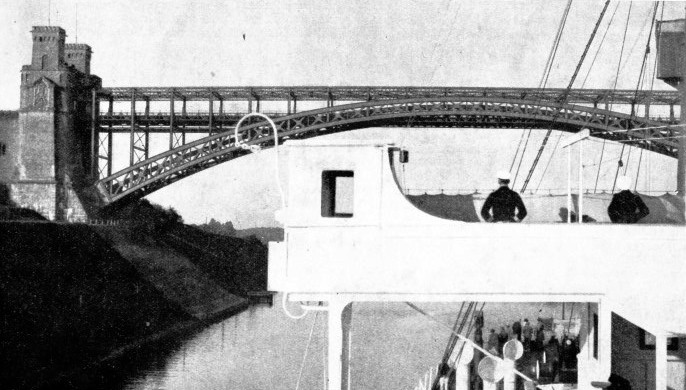
FROM THE NAVIGATING BRIDGE of a passenger liner it often appears that the vessel may not clear the arches of the rail and road bridges that cross the Kiel Canal. The bridge shown in this photograph, taken from the Atlantis, crosses the canal at Grunental.
You can read more on “German Shipping”, “The Surrender of the German Fleet” and “World Waterways” on this website.